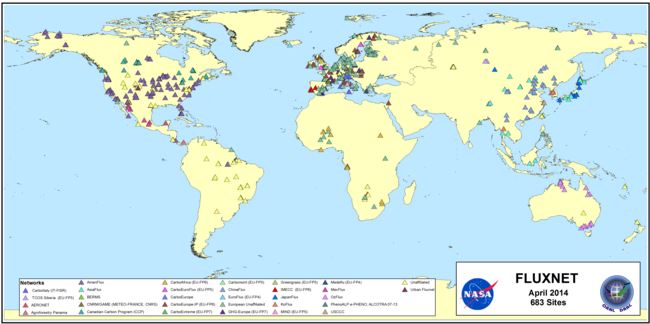At present over 650 tower sites are operated on a long-term and continuous basis. Vegetation under study includes temperate conifer and broadleaved (deciduous and evergreen) forests, tropical and boreal forests, crops, grasslands, chaparral, wetlands and tundra. Sites can be associated with regional or domain networks or can be unaffiliated. Flux towers operate on five continents and their latitudinal distribution ranges from 70 degrees north to 30 degrees south.
The FLUXNET database contains information about tower location and site characteristics as well as data availability (See FLUXNET Database). Eddy covariance data at 30-minute frequency are typically maintained, not by FLUXNET, but by individual towers or by networks to enable standardized data processing, gap-filling, and formats.
 Our community is interested in assessing the net uptake of carbon dioxide by the biosphere, not the flux across some arbitrary horizontal plane. When the thermal stratification of the atmosphere is stable and turbulent mixing is weak, material diffusing from leaves and the soil may not reach the reference height zr in a time that is small compared to the averaging time T, thereby violating the assumption of steady state conditions and a constant flux layer. Under such conditions the storage term becomes non-zero, so it must be added to the eddy covariance measurement to represent the balance of material flowing into and out of the soil and vegetation. With respect to CO2, the storage term is small over short crops and is an important quantity over taller forests. The storage term value is greatest around sunrise and sunset when there is a transition between respiration and photosynthesis and between the stable nocturnal boundary layer and daytime convective turbulence. Summed over 24 hours, the storage term is assumed to be zero.
Our community is interested in assessing the net uptake of carbon dioxide by the biosphere, not the flux across some arbitrary horizontal plane. When the thermal stratification of the atmosphere is stable and turbulent mixing is weak, material diffusing from leaves and the soil may not reach the reference height zr in a time that is small compared to the averaging time T, thereby violating the assumption of steady state conditions and a constant flux layer. Under such conditions the storage term becomes non-zero, so it must be added to the eddy covariance measurement to represent the balance of material flowing into and out of the soil and vegetation. With respect to CO2, the storage term is small over short crops and is an important quantity over taller forests. The storage term value is greatest around sunrise and sunset when there is a transition between respiration and photosynthesis and between the stable nocturnal boundary layer and daytime convective turbulence. Summed over 24 hours, the storage term is assumed to be zero.



